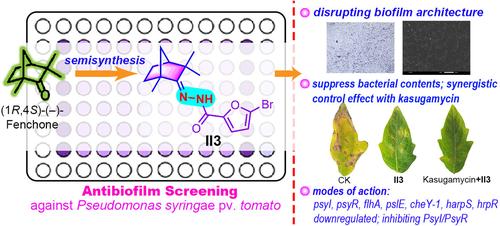当前位置:
X-MOL 学术
›
Pest Manag. Sci.
›
论文详情
Our official English website, www.x-mol.net, welcomes your
feedback! (Note: you will need to create a separate account there.)
Synthesis of antibiofilm (1R,4S)‐(−)‐fenchone derivatives to control Pseudomonas syringae pv. tomato
Pest Management Science ( IF 3.8 ) Pub Date : 2024-11-06 , DOI: 10.1002/ps.8525 Delong Wang, Yunpeng Li, Linjing Li, Yizhe Chen, Shuoling Min, Yong Wang, Juntao Feng, Jianbo Zhou, Zhijia Zhang, Yali Fang
Pest Management Science ( IF 3.8 ) Pub Date : 2024-11-06 , DOI: 10.1002/ps.8525 Delong Wang, Yunpeng Li, Linjing Li, Yizhe Chen, Shuoling Min, Yong Wang, Juntao Feng, Jianbo Zhou, Zhijia Zhang, Yali Fang

|
BACKGROUNDBiofilm plays a crucial role in Pseudomonas syringae pv. tomato (Pst ) infection. We identified (1R ,4S )‐(−)‐fenchone (FCH) as the most potent antibiofilm agent against Pst among 39 essential oil compounds. Subsequently, we synthesized a series of FCH oxime ester and acylhydrazine derivatives to explore more potent derivatives.RESULTSII3 was screened out as the most potent derivative, exhibiting a minimal biofilm inhibitory concentration of 60 μg mL−1 and a lowest concentration with maximal biofilm inhibition (LCMBI) of 200 μg mL−1 , lower than those of FCH (80 and 500 μg mL−1 , respectively). II3 and FCH showed minimum inhibitory concentration values >1000 μg mL−1 and similar maximal biofilm inhibition extents of 48.7% and 49.5% at their respective LCMBIs, respectively. Meanwhile, neither of them influenced cell viability or the activity of metabolic enzymes at their respective LCMBIs. II3 at its LCMBI significantly reduced biofilm thickness, extracellular polysaccharide content, and pectinase and cellulase production indices. In vivo assay results indicated that II3 could preventatively reduce the bacterial contents in tomato leaves at its LCMBI, and when combined with kasugamycin (KSG) (10 μg mL−1 ), II3 achieved the same level of bacterial reduction as the sole application of KSG (70 μg mL−1 ), thereby reducing the required dosage of KSG. Mechanistic studies demonstrated that II3 can down‐regulate biofilm‐related genes and inhibit PsyR/PsyI quorum sensing system, which differs from the bactericidal mechanisms.CONCLUSIONThese results underscore the potential of II3 as an antibiofilm agent for the control of Pst or FCH as a promising natural candidate for future in‐depth optimization. © 2024 Society of Chemical Industry.
中文翻译:

合成抗生物膜 (1R,4S) ‐ ( - )‐ fenchone 衍生物以控制丁香假单胞菌 pv。番茄
背景Biofilm 在 Pseudomonas syringae pv 中起着至关重要的作用。番茄 (Pst) 感染。我们确定 (1R,4S)‐(−)‐芬氏酮 (FCH) 是 39 种精油化合物中最有效的抗 Pst 生物膜剂。随后,我们合成了一系列 FCH 肟酯和酰肼衍生物,以探索更有效的衍生物。RESULTSII3被筛选为最有效的衍生物,表现出 60 μg mL-1 的最小生物膜抑制浓度和 200 μg mL-1 的最小生物膜抑制浓度 (LCMBI),低于 FCH 的浓度(分别为 80 和 500 μg mL-1)。II3 和 FCH 在各自的 LCMBI 下显示最小抑制浓度值 >1000 μg mL-1 和相似的最大生物膜抑制程度分别为 48.7% 和 49.5%。同时,它们都不会影响各自 LCMBI 的细胞活力或代谢酶活性。II3 在其 LCMBI 下显著降低生物膜厚度、细胞外多糖含量以及果胶酶和纤维素酶产生指数。体内测定结果表明,II3 可以预防性降低番茄叶片中 LCMBI 的细菌含量,当与春日霉素 (KSG) (10 μg mL-1) 联合使用时,II3 实现了与单独施用 KSG (70 μg mL-1) 相同的细菌减少水平,从而减少了所需的 KSG 剂量。机制研究表明,II3 可以下调生物膜相关基因并抑制 PsyR/PsyI 群体感应系统,这与杀菌机制不同。结论这些结果强调了 II3 作为控制 Pst 或 FCH 的抗生物膜剂的潜力,作为未来深入优化的有前途的天然候选者。© 2024 化工学会.
更新日期:2024-11-06
中文翻译:

合成抗生物膜 (1R,4S) ‐ ( - )‐ fenchone 衍生物以控制丁香假单胞菌 pv。番茄
背景Biofilm 在 Pseudomonas syringae pv 中起着至关重要的作用。番茄 (Pst) 感染。我们确定 (1R,4S)‐(−)‐芬氏酮 (FCH) 是 39 种精油化合物中最有效的抗 Pst 生物膜剂。随后,我们合成了一系列 FCH 肟酯和酰肼衍生物,以探索更有效的衍生物。RESULTSII3被筛选为最有效的衍生物,表现出 60 μg mL-1 的最小生物膜抑制浓度和 200 μg mL-1 的最小生物膜抑制浓度 (LCMBI),低于 FCH 的浓度(分别为 80 和 500 μg mL-1)。II3 和 FCH 在各自的 LCMBI 下显示最小抑制浓度值 >1000 μg mL-1 和相似的最大生物膜抑制程度分别为 48.7% 和 49.5%。同时,它们都不会影响各自 LCMBI 的细胞活力或代谢酶活性。II3 在其 LCMBI 下显著降低生物膜厚度、细胞外多糖含量以及果胶酶和纤维素酶产生指数。体内测定结果表明,II3 可以预防性降低番茄叶片中 LCMBI 的细菌含量,当与春日霉素 (KSG) (10 μg mL-1) 联合使用时,II3 实现了与单独施用 KSG (70 μg mL-1) 相同的细菌减少水平,从而减少了所需的 KSG 剂量。机制研究表明,II3 可以下调生物膜相关基因并抑制 PsyR/PsyI 群体感应系统,这与杀菌机制不同。结论这些结果强调了 II3 作为控制 Pst 或 FCH 的抗生物膜剂的潜力,作为未来深入优化的有前途的天然候选者。© 2024 化工学会.


















































 京公网安备 11010802027423号
京公网安备 11010802027423号